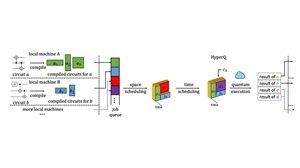Tools & Platforms
Agentic AI, Quantum, Blockchain Reshape Industries

In the fast-evolving world of technology, 2025 is emerging as a pivotal year where artificial intelligence isn’t just augmenting human capabilities but fundamentally reshaping entire industries. According to a recent analysis from McKinsey, agentic AI—systems that autonomously make decisions and execute tasks—is topping the list of transformative trends, promising to boost efficiency in sectors from finance to healthcare. This shift comes amid a surge in investments, with companies like Microsoft and Google pouring billions into AI infrastructure to monetize cloud services more aggressively.
Beyond AI, quantum computing is gaining traction as a game-changer for complex problem-solving. Posts on X highlight how quantum advancements are set to revolutionize cryptography and drug discovery, with users noting breakthroughs in scalable quantum processors. Meanwhile, blockchain’s integration with AI is fostering greater transparency in supply chains, as seen in healthcare applications where secure data sharing could cut costs by up to 30%, per insights from WebProNews.
Navigating Ethical and Regulatory Hurdles
As these innovations accelerate, ethical concerns are mounting. Industry executives are grappling with AI’s potential biases and the need for robust governance, especially as multilingual generative AI expands into global markets. A report from Simplilearn underscores the importance of upskilling workforces to handle these tools, warning that without it, companies risk falling behind in a competitive race.
Sustainability is another critical thread, with tech firms prioritizing green computing to reduce carbon footprints. McKinsey’s outlook points to edge computing as a key enabler, allowing data processing closer to the source and minimizing energy use in data centers. This aligns with broader environmental goals, as evidenced by BBC Innovation’s coverage of AI-driven climate modeling that could optimize renewable energy grids.
Autonomous Systems and Connectivity Boom
The rise of autonomous systems, including Level 5 robotaxis, is poised to disrupt transportation. X users are buzzing about 6G networks launching for ultra-fast connectivity, enabling real-time applications in remote surgery and smart cities. Fortune’s tech section reports that such advancements could add trillions to global GDP, but scalability remains a challenge amid regulatory scrutiny.
In parallel, virtual and augmented reality are maturing beyond gaming into enterprise tools for training and collaboration. DevTechnosys, in a recent post on X, lists AR/VR as a top trend for immersive experiences that enhance productivity in manufacturing and education.
Investment Strategies and Market Shifts
Investors are eyeing digital banks and AI infrastructure as high-growth areas. An X thread from financial analysts predicts that cloud giants like Amazon and Alibaba will dominate monetization efforts, driving stock surges. However, Reuters Tech News cautions about potential bubbles, citing overvaluations in quantum startups amid economic uncertainties.
Challenges like ROI measurement and talent shortages persist, as noted in McKinsey’s deep dive. Companies are urged to form strategic partnerships to navigate these, with examples like Tesla’s EV innovations illustrating how bold bets on tech can yield market dominance.
Looking Ahead to Broader Impacts
The convergence of these trends—AI with IoT, blockchain, and 5G—is creating hybrid ecosystems that promise strategic advantages. SA News Channel’s X updates emphasize real-time business intelligence as a byproduct, enabling faster decision-making. Yet, as CNN Business highlights, geopolitical tensions could hinder global adoption, particularly in chip manufacturing.
Ultimately, 2025’s tech innovations demand agile leadership. By prioritizing ethics, sustainability, and continuous learning, industry insiders can harness these forces for long-term growth, transforming potential disruptions into opportunities for reinvention.
Tools & Platforms
ExamJam SAT as a Disruptive Force in Affordable, Effective Tutoring

The test-prep industry is undergoing a seismic shift as artificial intelligence redefines the economics and efficacy of academic support. At the forefront of this transformation is ExamJam SAT, a digital platform leveraging adaptive algorithms to deliver personalized SAT preparation at a fraction of traditional tutoring costs. For investors, the case for ExamJam is compelling: it addresses the limitations of conventional methods while aligning with broader trends in education technology, equity, and digital accessibility.
The Flawed Promise of Traditional Tutoring
Traditional one-on-one tutoring, long the gold standard for SAT prep, has shown mixed results. A 2025 study by Belator et al. found no significant score improvements for tutored students compared to self-study groups, despite hourly rates averaging $50–$90 [2]. Even high-profile providers like The Princeton Review, which charges up to $6,560 for private tutoring, report only modest gains—typically 100–200 points—across their programs [4]. Meanwhile, the College Board’s analysis of 2 million test-takers revealed that tutoring’s average impact is just 33 points, far below the 115-point boost achievable through 20 hours of free Khan Academy practice [4].
These inefficiencies stem from structural flaws: rigid pricing models, inconsistent tutor quality, and a reliance on generic practice tests. As one Reddit user lamented, “Nearly 1.5 years of tutoring and my score hasn’t improved” [1]. Such anecdotes underscore a market in need of disruption.
ExamJam’s AI-Driven Edge
ExamJam SAT positions itself as a solution to these challenges. By integrating adaptive learning technologies, the platform tailors practice sessions to individual weaknesses, a feature proven to enhance retention. A 2025 report by Dialzara found that AI platforms improve 6-month retention rates by 22% compared to traditional methods, a critical advantage in a market where 40% of students abandon prep programs within three months [6].
Cost efficiency further strengthens ExamJam’s appeal. While traditional tutoring ranges from $20–$349 per hour [1], ExamJam’s subscription model costs $20–$60/month, offering 24/7 access to AI-driven diagnostics, simulated testing environments, and real-time feedback. This aligns with broader industry trends: online platforms like Magoosh and PrepScholar already undercut traditional rates by 40–60% while delivering comparable results [4].
Score Improvements and Market Validation
The data on score gains is equally persuasive. Marks Education, a peer in the AI-driven space, reported a 166-point average improvement for its 2025 cohort, with low-scoring students (950–1050) seeing gains of 200+ points [5]. While ExamJam’s specific metrics remain undisclosed, its use of adaptive algorithms mirrors the methodologies of successful platforms like Prep Expert, which claims a 10–15% score lift through personalized practice [2].
Moreover, the digital SAT’s shift to adaptive testing in 2024 creates a natural synergy. Platforms like ExamJam, designed for dynamic question formats, can simulate real-world conditions more effectively than static paper-based prep. This is a strategic advantage as 78% of 2025 test-takers now opt for the digital format [3].
Equity and Scalability: A Dual Impact
ExamJam’s disruptive potential extends beyond economics. By offering tiered pricing and fee waivers, it democratizes access to high-quality prep, countering critiques that standardized tests favor wealthier students. This aligns with College Board initiatives to expand fee waivers and eliminate late registration penalties [3]. For investors, this represents both ethical and financial upside: a 2025 EdisonOS report noted a 12% year-over-year increase in SAT participation from underrepresented communities [3].
Risks and Considerations
Critics argue that AI lacks the nuanced guidance of human tutors, particularly for complex problem-solving. However, hybrid models—combining AI diagnostics with occasional human check-ins—are gaining traction. Platforms like PrepMaven already blend AI tools with $79–$349/hour expert sessions, suggesting a path for ExamJam to scale without sacrificing quality [1].
Conclusion: A Lucrative Long-Term Bet
ExamJam SAT embodies the future of test prep: affordable, data-driven, and scalable. With traditional tutoring’s ROI increasingly called into question and digital adoption accelerating, the platform is well-positioned to capture market share. For investors, the opportunity lies not just in profit but in reshaping an industry that has long struggled to balance cost, effectiveness, and equity.
**Source:[1] 15 Best Online SAT Tutoring Services for 2025 (PrepMaven)
https://prepmaven.com/blog/test-prep/best-sat-tutoring/[2] The Impact of Test Prep Tutoring (TPAPT Research)
https://tpapt.mykajabi.com/blog/tutoringresearch[3] SAT Trends 2025: Shaping the Future of Test Takers (EdisonOS)
https://www.edisonos.com/digital-sat/sat-trends[4] Do Tutored High School Students Obtain Better SAT Scores? (Total College Prep)
https://www.totalcollegeprep.net/do-tutored-high-school-students-garner-higher-sat-scores/[5] Announcing the Score Improvements for the Class of 2025 (Marks Education)
https://markseducation.com/announcing-the-score-improvements-for-the-class-of-2025/[6] AI Tutoring vs. Traditional Tutoring (Dialzara)
https://dialzara.com/blog/ai-tutoring-vs-traditional-tutoring-key-differences
Tools & Platforms
The Top 10 Boxers of All Time According to AI

By Richard D. Harroch and Dominique A. Harroch
Boxing is more than just a sport—it’s a theater of discipline, resilience, and raw power. The stories of boxing’s greatest champions are woven with tales of triumph over adversity, breathtaking victories, and an unmatched hunger for glory. These athletes step into the ring not only to battle their opponents but also to confront their own limits, pushing the boundaries of what the human spirit can endure.
Over the decades, boxing has produced some of the most celebrated athletes in history. Each generation has seen fighters who redefined the sport, brought crowds to their feet, and etched their names into the annals of greatness. These boxers weren’t just skilled pugilists; they were cultural icons who inspired millions with their courage and determination.
In this article, we count down the top 10 boxers of all time, with research assistance from ChatGPT. These fighters earned their places on this list through a combination of skill, legacy, and impact both inside and outside the ring.
1. Muhammad Ali
Muhammad Ali was a larger-than-life figure who transcended the sport of boxing. With his unmatched charisma, lightning-fast reflexes, and a fighting style as poetic as his words, Ali dominated the heavyweight division and became a global icon for his activism and larger-than-life personality.
- Nickname: The Greatest
- Weight Class: Heavyweight
- Record: 56 wins (37 KOs), 5 losses
- Notable Fights: “The Rumble in the Jungle” against George Foreman, “The Thrilla in Manila” against Joe Frazier
- Legacy Outside the Ring: Advocate for civil rights and a symbol of resistance against oppression
- Awards: Three-time heavyweight champion and Olympic gold medalist (1960)
2. Sugar Ray Robinson
Many regard Sugar Ray Robinson as the greatest pound-for-pound boxer in history. Known for his impeccable technique, speed, and power, Robinson dominated the welterweight and middleweight divisions with ease.
- Nickname: Sugar
- Weight Class: Welterweight, middleweight
- Record: 173 wins (108 KOs), 19 losses, 6 draws
- Notable Fights: Epic rivalry with Jake LaMotta, known as the “St. Valentine’s Day Massacre”
- Style: Fluid footwork and deadly counterpunching
- Legacy: The benchmark for boxing greatness; inspired the creation of the pound-for-pound ranking
- Impact: Revolutionized the way fighters approached the sport with his finesse
3. Mike Tyson
Mike Tyson was a force of nature in the 1980s, earning the nickname “Iron Mike” for his devastating power and relentless aggression. He became the youngest heavyweight champion in history at just 20 years old.
- Nickname: Iron Mike
- Weight Class: Heavyweight
- Record: 50 wins (44 KOs), 6 losses
- Notable Fights: Dominant first-round KO of Michael Spinks in 91 seconds
- Fighting Style: Aggressive, with an explosive combination of speed and power
- Legacy: Known for his intimidating persona and spectacular knockouts
- Impact: Brought global attention to the heavyweight division during his reign
4. Floyd Mayweather Jr.
Floyd Mayweather Jr. is synonymous with defensive brilliance and technical mastery. Undefeated throughout his career, Mayweather built his success on his ability to outthink and outmaneuver every opponent.
- Nickname: Money, Pretty Boy
- Weight Class: Welterweight, Super featherweight, lightweight
- Record: 50 wins (27 KOs), 0 losses
- Notable Fights: Defeated Manny Pacquiao in one of the highest-grossing fights in history
- Fighting Style: Exceptional defense, counterpunching, and ring IQ
- Legacy: Considered the best defensive boxer in history
- Impact: Revolutionized boxing as a business with his promotional savvy
5. Joe Louis
Joe Louis was a dominant heavyweight who held the title for a record 12 years. His technical skills, combined with his knockout power, made him one of the most feared fighters of his era.
- Nickname: Brown Bomber
- Weight Class: Heavyweight
- Record: 66 wins (52 KOs), 3 losses
- Notable Fights: Victory over Max Schmeling in their rematch, symbolizing democracy versus fascism
- Legacy: A unifying figure during World War II and a symbol of hope for African Americans
- Awards: Longest reign as heavyweight champion in history
- Impact: Elevated boxing’s popularity worldwide
6. Manny Pacquiao
Manny Pacquiao is the only boxer in history to win world titles in eight different weight classes. Known for his relentless work ethic and humility, Pacquiao combined power, speed, and charisma to become a global sports icon.
- Nickname: Pac-Man
- Weight Class: Flyweight to welterweight
- Record: 62 wins (39 KOs), 8 losses, 2 draws
- Notable Fights: Trilogy against Juan Manuel Márquez, victory over Oscar De La Hoya
- Style: Aggressive and fast-paced, with relentless combinations
- Legacy: Transcended boxing to become a political leader in the Philippines
- Impact: Inspired millions with his rise from poverty to global fame
7. George Foreman
George Foreman is best known for his devastating power and two careers as a world-class boxer. After an early retirement, Foreman made a stunning comeback, reclaiming the heavyweight title at 45 years old.
- Nickname: Big George
- Weight Class: Heavyweight
- Record: 76 wins (68 KOs), 5 losses
- Notable Fights: Victory over Michael Moorer at age 45 to regain the heavyweight title
- Legacy: Represented perseverance and longevity in sports
- Impact: Successfully transitioned into entrepreneurship with the George Foreman Grill
8. Roberto Durán
Roberto Durán is one of the most ferocious fighters in boxing history. He dominated the lightweight division before becoming a world champion in four weight classes.
- Nickname: Hands of Stone
- Weight Class: Lightweight to middleweight
- Record: 103 wins (70 KOs), 16 losses
- Notable Fights: Victory over Sugar Ray Leonard in the “Brawl in Montreal”
- Style: Aggressive, relentless pressure with powerful punches
- Legacy: One of the most skilled and versatile fighters of all time
- Impact: Revered in his native Panama as a national hero
9. Rocky Marciano
Rocky Marciano remains the only heavyweight champion in history to retire undefeated. Known for his relentless pressure and incredible durability, Marciano’s 49-0 record remains legendary.
- Nickname: The Brockton Blockbuster
- Weight Class: Heavyweight
- Record: 49 wins (43 KOs), 0 losses
- Notable Fights: Knockout victory over Joe Louis in Louis’ final fight
- Legacy: Embodied the spirit of determination and grit
- Impact: Inspired the fictional Rocky Balboa character
- Awards: Inducted into the Boxing Hall of Fame
Evander Holyfield was a master technician and one of the best pound-for-pound fighters in history. His epic battles with Mike Tyson and Riddick Bowe defined an era.
- Nickname: The Real Deal
- Weight Class: Cruiserweight, heavyweight
- Record: 44 wins (29 KOs), 10 losses, 2 draws
- Notable Fights: Trilogy against Riddick Bowe, upset victory over Mike Tyson
- Style: Exceptional stamina and ring intelligence
- Legacy: The only four-time heavyweight champion in history
- Impact: Cemented his reputation as one of boxing’s toughest competitors
Conclusion on Boxing Legends
Boxing’s greatest champions are more than just athletes—they’re symbols of perseverance, grit, and the relentless pursuit of greatness. Each of these boxers left an indelible mark on the sport, captivating audiences with their skill, bravery, and unforgettable moments in the ring.
Whether it’s Muhammad Ali’s charisma, Mike Tyson’s ferocity, or Floyd Mayweather’s technical mastery, these fighters represent the pinnacle of boxing excellence. Their legacies extend beyond the ropes, inspiring generations and cementing their places in history as legends of the sport.
Related Articles:
About the Authors
Richard D. Harroch is a Senior Advisor to CEOs, management teams, and Boards of Directors. He is an expert on M&A, venture capital, startups, and business contracts. He was the Managing Director and Global Head of M&A at VantagePoint Capital Partners, a venture capital fund in the San Francisco area. His focus is on internet, digital media, AI and technology companies. He was the founder of several Internet companies. His articles have appeared online in Forbes, Fortune, MSN, Yahoo, Fox Business and AllBusiness.com. Richard is the author of several books on startups and entrepreneurship as well as the co-author of Poker for Dummies and a Wall Street Journal-bestselling book on small business. He is the co-author of a 1,500-page book published by Bloomberg on mergers and acquisitions of privately held companies. He was also a corporate and M&A partner at the international law firm of Orrick, Herrington & Sutcliffe. He has been involved in over 200 M&A transactions and 250 startup financings. He can be reached through LinkedIn.
Dominique Harroch is the Chief of Staff at AllBusiness.com. She has acted as a Chief of Staff or Operations Leader for multiple companies where she leveraged her extensive experience in operations management, strategic planning, and team leadership to drive organizational success. With a background that spans over two decades in operations leadership, event planning at her own start-up and marketing at various financial and retail companies, Dominique is known for her ability to optimize processes, manage complex projects and lead high-performing teams. She holds a BA in English and Psychology from U.C. Berkeley and an MBA from the University of San Francisco. She can be reached via LinkedIn.
Copyright (c) by Richard D. Harroch. All Rights Reserved.
Tools & Platforms
Half of firms lack AI expertise despite rising interest in EAM tech

A global survey of maintenance professionals has found that almost half of industrial businesses lack internal expertise to adopt advanced tools such as artificial intelligence.
The Ultimo Maintenance Trend Report, based on input from over 200 maintenance professionals worldwide, highlights how emerging technologies including AI, machine learning, and digital twins are increasingly being recognised as key enablers in enterprise asset management (EAM). The report also points to persistent workforce challenges and the important role of human skill in the successful implementation of these next-generation tools.
Shift to next-generation technologies
According to the survey, there has been a significant increase in interest in advanced technologies since the last Ultimo EAM Trend Report in 2023. When respondents were asked about which innovations they believe will have the most positive impact on their maintenance and business practices, contextual intelligence was cited by 68% of participants, markedly up from 8% one year earlier. Automation and robotics (49%) and machine learning (41%) were also highlighted as areas of strong interest. The proportion of professionals interested in digital twins has more than doubled, now reaching 40%.
Despite the interest in and potential benefits of these technologies, some significant barriers remain. The survey found that 49% of respondents lack the internal expertise necessary to implement advanced tools like AI and machine learning. For many organisations, this skills gap poses a key challenge to the wider adoption of digital technologies in industrial asset management.
Workforce challenges
The survey data also indicates that workforce issues continue to be a dominant concern. An aging workforce was identified as the most pressing trend impacting maintenance strategy by 63% of respondents, underlining the urgency of knowledge transfer and workforce planning for businesses in asset-heavy sectors. In parallel, 50% of participants stated that recruiting experienced staff was their primary source of disruption over the past year, suggesting that both immediate and long-term workforce needs are being keenly felt.
Insights from Ultimo
“From global instability to changing regulations, socio-economic and political shifts are creating uncertainty across industries. In this environment, agility is critical,” said Berend Booms, Head of EAM Insights at Ultimo, an IFS company. “EAM can also serve as a catalyst for innovation. Internet of Things (IoT), AI, ML, digital twins, and predictive analytics are rapidly transforming industrial businesses. They unlock smarter decision-making, greater efficiency, and a sharper competitive edge.”
Role of data and analytics in asset maintenance
The report further explores how increased availability of real-time data, enabled by technologies such as IoT and predictive analytics, is contributing to the evolution of EAM systems. The perceived impact of predictive modelling has tripled according to this year’s findings compared with the previous year’s survey. Yet, with 49% of businesses citing inadequate internal know-how as a limiting factor, practical uptake remains uneven across industries and markets.
Modern EAM systems have moved beyond solely serving as record-keeping tools. By integrating AI and maintenance data, these systems are now being used to produce actionable insights, helping maintenance teams anticipate needs and transition from reactive repairs to proactive strategies. This shift, according to the research, is enabling organisations to improve efficiency, reduce downtime, and derive greater value from their maintenance investments.
Ultimo has introduced AI-powered EAM features designed to be accessible and deployable without the need for in-house AI model development or significant infrastructure investments. These capabilities aim to lower adoption barriers and facilitate immediate operational improvements for asset-heavy enterprises.
The Maintenance Trend Report, which contains contributions from Verdantix, TwinThread, ABS Consulting, and MaxGrip, states that blending human expertise with intelligent systems is likely to be the most effective approach as businesses strive to enhance their asset maintenance functions. As noted in the report, technology alone does not provide a complete solution, but the combination of skilled professionals and advanced digital tools is shaping future directions in maintenance management.
The survey captured perspectives from professionals working in sectors including manufacturing, healthcare, energy, utilities, telecommunications, transportation, and logistics, across a wide range of company sizes. Respondents were drawn from Austria, Belgium, Czech Republic, Denmark, Finland, Germany, Iceland, Luxembourg, Netherlands, Norway, UK, USA, and Sweden.
-

 Business5 days ago
Business5 days agoThe Guardian view on Trump and the Fed: independence is no substitute for accountability | Editorial
-
Tools & Platforms3 weeks ago
Building Trust in Military AI Starts with Opening the Black Box – War on the Rocks
-

 Ethics & Policy1 month ago
Ethics & Policy1 month agoSDAIA Supports Saudi Arabia’s Leadership in Shaping Global AI Ethics, Policy, and Research – وكالة الأنباء السعودية
-

 Events & Conferences4 months ago
Events & Conferences4 months agoJourney to 1000 models: Scaling Instagram’s recommendation system
-

 Jobs & Careers2 months ago
Jobs & Careers2 months agoMumbai-based Perplexity Alternative Has 60k+ Users Without Funding
-

 Education2 months ago
Education2 months agoVEX Robotics launches AI-powered classroom robotics system
-

 Funding & Business2 months ago
Funding & Business2 months agoKayak and Expedia race to build AI travel agents that turn social posts into itineraries
-

 Podcasts & Talks2 months ago
Podcasts & Talks2 months agoHappy 4th of July! 🎆 Made with Veo 3 in Gemini
-

 Podcasts & Talks2 months ago
Podcasts & Talks2 months agoOpenAI 🤝 @teamganassi
-

 Education2 months ago
Education2 months agoAERDF highlights the latest PreK-12 discoveries and inventions





















